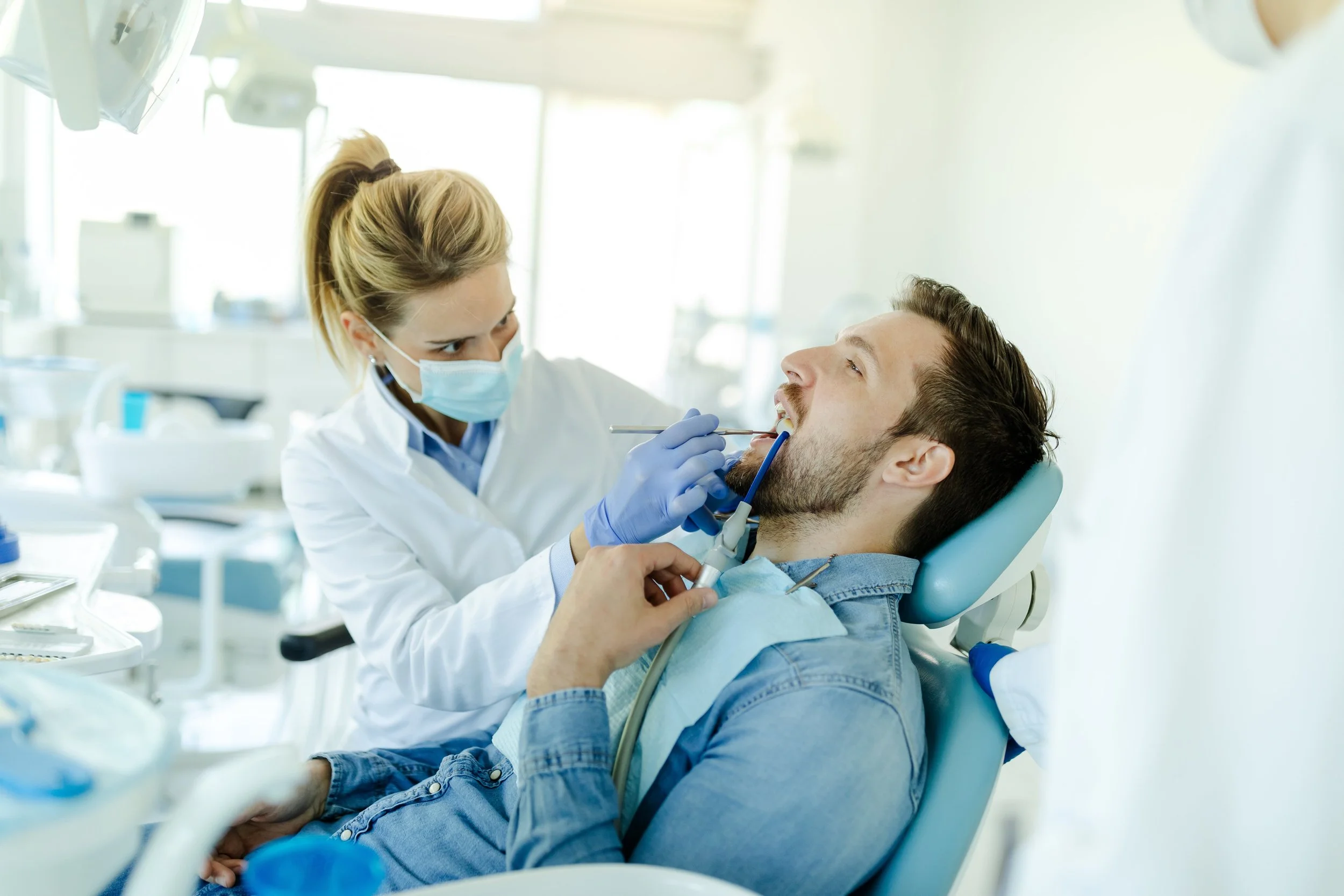How Long for “Novocaine” to Wear Off? (Modern Dental Numbing Explained)
At a Glance:
Numbness lasts 2–4 hours.
Dentists use lidocaine, not novocaine.
Epinephrine makes it last longer.
Heart flutter usually comes from epinephrine; true allergies are very rare.
How Long Does “Novocaine” Last?
Most dental numbness typically wears off within 2 to 4 hours, depending on the anesthetic used and whether epinephrine is included. What most people call “novocaine” (which was actually a brand name for the older drug procaine) isn’t actually used anymore.
Modern dentistry uses safer, longer-lasting options like lidocaine, articaine, or mepivacaine. These provide reliable numbness so you stay comfortable during treatment.
If your lips, cheeks, or tongue are still numb after a few hours, that’s normal. The numb feeling almost always fades the same day.
At Park Slope Dentistry Seventh Avenue, Dr. Freking and her team use modern anesthetics with gentle care to keep Brooklyn patients comfortable.
What Do We Actually Use Today?
When people say “novocaine,” they’re usually thinking of the numbing shot dentists give before a procedure.
But here’s the truth: Novocaine (procaine) hasn’t been used in dentistry for decades. It was an older drug in the ester class that could cause allergic reactions and didn’t last very long.
Today, dentists rely on safer and more effective amide anesthetics such as:
Lidocaine – the gold standard, reliable and safe.
Articaine – a stronger anesthetic, sometimes lasts longer.
Mepivacaine – a good option when epinephrine isn’t ideal. Dr Freking loves this option for shorter duration treatment, as it wears off faster (and you can feel your face again faster).
Bupivacaine – the longest-lasting (around 6-8 hours), but usually reserved for oral surgery or complex cases.
Why the switch?
These modern anesthetics provide more predictable numbness, longer comfort, and fewer side effects. Allergies to them are extremely rare, almost theoretical.
What some patients think is an “allergy” (like a racing heartbeat or shaky feeling) is usually a response to the tiny amount of epinephrine included in the anesthetic. Epinephrine (also referred to as adrenaline, something your body makes on its own) helps the numbness stay local and last longer, but it can briefly make your heart beat faster.
How Long Does Dental Numbing Last?
| Anesthetic | Typical Tooth Numbness (Pulpal) | Soft Tissue (Lips/Cheeks) | Notes |
|---|---|---|---|
| Lidocaine + epinephrine | 60–90 minutes | 3–3.5 hours | Gold standard; safe and reliable |
| Articaine + epinephrine | Similar to lidocaine | Sometimes slightly longer | Often used for cases where pain is present |
| Mepivacaine (no epi) | 30-90 minutes | 1–2 hours | Good option if epi isn’t suitable or the procedure is expected to be short |
| Bupivacaine | 2–3 hours | 6–8 hours | Longest lasting; often for oral surgery |
Fun fact: Lidocaine has been the “go-to” dental anesthetic for over 70 years because of its safety record.
So…How Long Until I’m Not Numb?
For most patients, the numb feeling lasts about 2–4 hours in the lips, cheeks, and tongue. The tooth itself is usually numb for 60–90 minutes, which is long enough to complete most fillings or routine procedures.
The exact timing can vary depending on:
Where the anesthetic is placed (a nerve block usually lasts longer than a local infiltration).
Whether epinephrine is included, since it keeps the anesthetic localized for a longer period.
Your individual metabolism and circulation.
The type and amount of anesthetic used.
Many articles still say “novocaine lasts 1–2 hours,” but in reality, modern anesthetics with epinephrine often keep soft tissues numb closer to 3–4 hours. That’s normal, and the feeling almost always wears off the same day.
Can I Make Numbness Wear Off Faster?
Most of the time, numbness simply has to fade as your body metabolizes the anesthetic. But there are a few safe ways to encourage circulation and comfort:
Gently move your jaw and lips to stimulate blood flow.
Apply a warm (not hot) compress to your cheek if it feels comfortable.
Lightly massage the area around (but not on) the injection site if it isn’t sore.
One thing to avoid? Chewing or biting while you’re still numb. It’s easy to accidentally bite your lip, cheek, or tongue without realizing it.
For patients who need sensation back more quickly (like kids or those with speaking needs), dentists sometimes use phentolamine mesylate (OraVerse). Studies show it can cut soft-tissue numbness time roughly in half. It’s not necessary for everyone, but you can always ask Dr. Freking if it’s right for your situation.
“My Heart Raced. Am I Allergic?”
It’s a common worry, but the truth is reassuring: a fluttery heartbeat or a brief rush of adrenaline after an injection isn’t an allergy. It usually comes from the epinephrine that’s mixed with the anesthetic.
Epinephrine helps the medication stay localized and last longer, but it can also mimic the body’s natural “fight or flight” response for a minute or two.
True allergies to the modern anesthetics dentists use (like lidocaine, articaine, or mepivacaine) are extremely rare and mostly theoretical. The older drug “Novocaine” (procaine) was more likely to trigger allergic reactions, which is one reason it’s no longer used in routine dentistry.
So if your heart races briefly, it’s almost always the epinephrine doing its job, not an allergic response. The feeling passes quickly and is considered safe for the vast majority of patients.
Key Takeaways
“Novocaine” isn’t used anymore. Modern anesthetics like lidocaine and articaine are safer and more effective.
Most patients feel the tooth numbness fade in 60–90 minutes, while lips, cheeks, and tongue stay numb for 2–4 hours.
How long it lasts depends on the anesthetic type, dosage, injection site, and whether epinephrine is included.
A mild racing heartbeat after an injection is usually from epinephrine, not an allergy.
True allergies to today’s anesthetics are extremely rare.
If numbness lasts much longer than expected or comes with swelling or pain, call your dentist right away.
Park Slope Dentistry Seventh Avenue: Comfortable, Modern Numbing
At Park Slope Dentistry Seventh Avenue, we take comfort seriously. Dr. Angelique Freking uses modern anesthetics like lidocaine and articaine with careful dosing tailored to each patient.
For those who are sensitive to epinephrine, we have options without it. And for children, we provide extra guidance to help them avoid lip or cheek biting while still numb. Our goal is to keep you comfortable, safe, and confident every step of the way.
Book your appointment online or call 718-866-4645 today.
Book Your Visit Today
FAQs
-
Most people stay numb for 2–4 hours. Tooth numbness fades first (about 60–90 minutes), while lips, cheeks, and tongue stay numb longer.
-
Novocaine was the first widely used local anesthetic, but it’s outdated. Today, dentists use safer, more effective medications like lidocaine, articaine, and mepivacaine.
-
Not instantly, but light movement, gentle massage, and a warm compress can help. Some offices offer a reversal option called OraVerse to cut recovery time in half.
-
Not usually. Some anesthetics naturally last 4–6 hours, and kids or older adults may metabolize them more slowly. If numbness lasts overnight or comes with swelling, call your dentist.
-
That’s almost always from epinephrine in the anesthetic, not an allergy. It helps keep the numbing effect local and wears off quickly.
-
Yes. Children sometimes stay numb a bit longer, and older adults may metabolize anesthetics more slowly. Your dentist adjusts the dose to keep you safe.





